“A palace that might have been built by Titans and coloured by the morning sun”
– Rudyard Kipling quoting Mehrangarh Fort
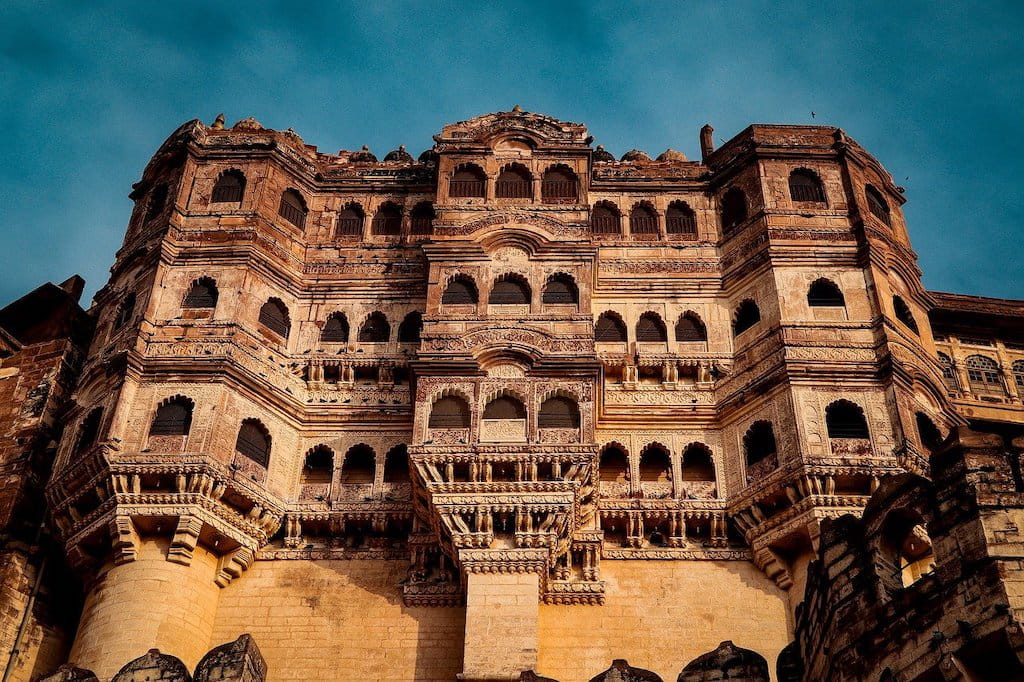
And believe me, there is no exaggeration into his quote. Mehrangarh fort is one of the most beautiful, massive and at the same time intricate architectural wonders of India. A trip to Jodhur, Rajasthan can simply not be completed without visiting the Mehrangarh Fort Jodhpur. After visiting the likes of Amer Fort, Jaigarh Fort, Nahargarh Fort, Chittorgarh Fort, Kumbhalgarh Fort and several other forts of Rajasthan, finally we visited Mehrangarh Fort ! And I must say I was super impressed by the way this fort is maintained. It is one of the cleanest & most well maintained forts in India. And also one of the most massive forts. Perched at a hill almost 400ft tall, overlooking the blue city of Jodhpur, the Mehrangarh Fort is very strategically located.
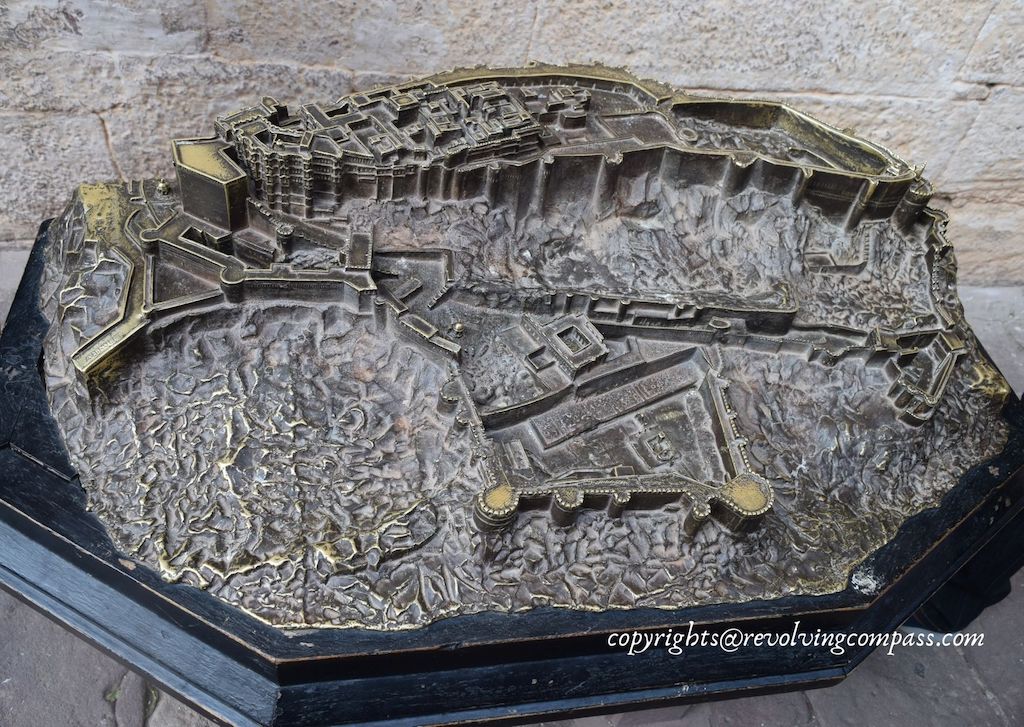
While visiting the fort, do remember that it was built by Rao Jodha in 1459 AD, centuries from now!! And you cannot help but marvel at the genius of engineering that this fort represents. Moreover, it’s massive walls, intricate carvings and expansive courtyards overlooking beautiful chambers are the testimony of its strength.
On our 2 days trip to Jodhpur, we dedicated almost one complete day exploring this architectural wonder from ancient India carved out of red sandstones and admiring it’s glory. We reached here around 9:00am. And took our entrance tickets as well as a guide to help us navigate through the countless alleys and chambers of the fort. And also help us understand it’s history better. As we passed through the sections of the fort, we felt transported into an era long bygone. And could clearly feel that era coming live in front of our eyes.
Table of Contents
A quick glance through the architecture of Mehrangarh Fort Jodhpur
To be honest, we got the first glimpse of Mehrangarh Fort the day we arrived in Jodhpur towards the evening. And were simply exploring the area around Clock Tower. Well, perched atop a high hill the fort is visible from most parts of the old city. And as soon as you see it’s walls from far under in the city, there is something that will intrigue you to visit here. However, we waited till the next morning. And officially started our exploration of the city of Jodhpur from here.
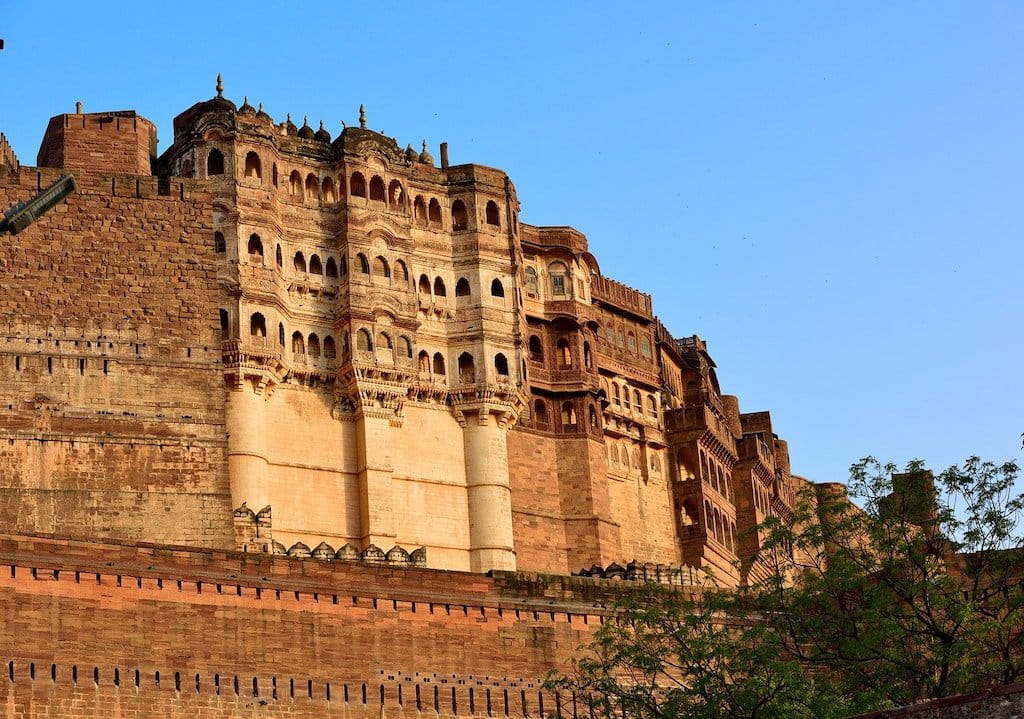
Although a lot has been said and written about the glorious and marvellous architecture of Mehrangarh Fort Jodhpur, I can’t imagine my narration to be complete without a quick mention of the most wonderful architectural marvels that you get to see as you navigate through this fort. So, let me quickly summarise that below, taking you through the journey inside the fort that we took. And then I will take you through some of the very interesting facts about this fort that kept us captivated and intrigued while we walked through it.
Shringar chowk
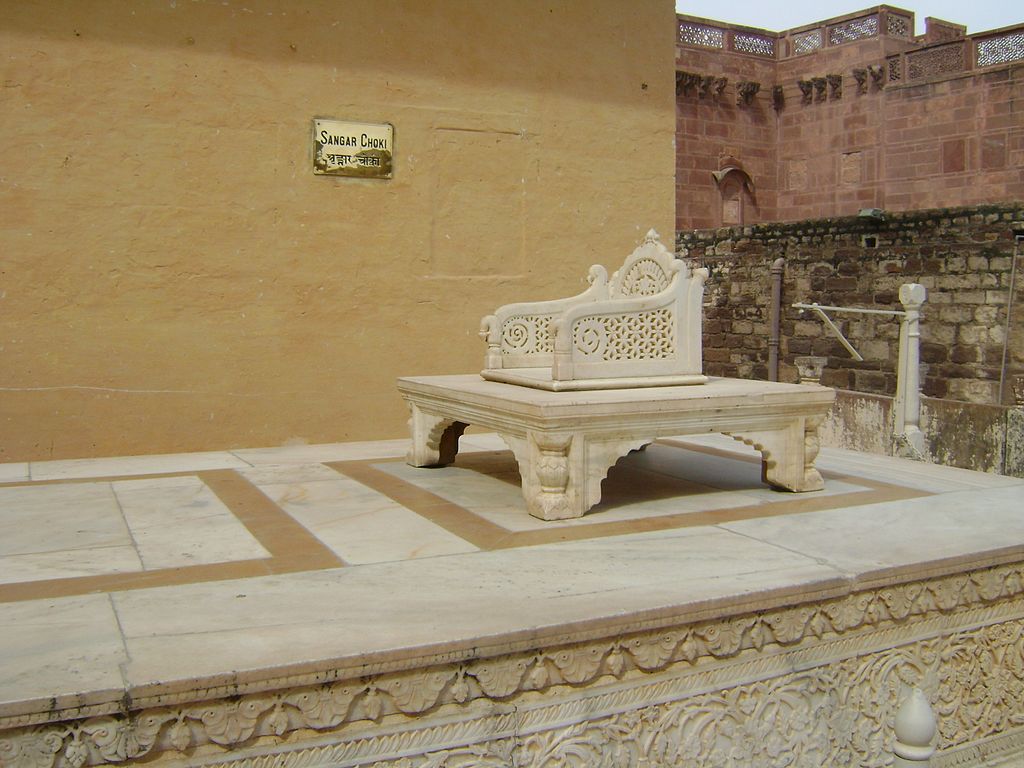
It is the first courtyard that you visit inside Mehrangarh Fort Jodhpur. A major feature of the Sringar Chowk is a marble throne in one corner where new ruler is presented to the people of Mehrangarh. Also, the jharokhas from the first floor of the area surrounding this courtyard have remarkably intricate carvings. And are particularly noticeable.
Daulat Khana
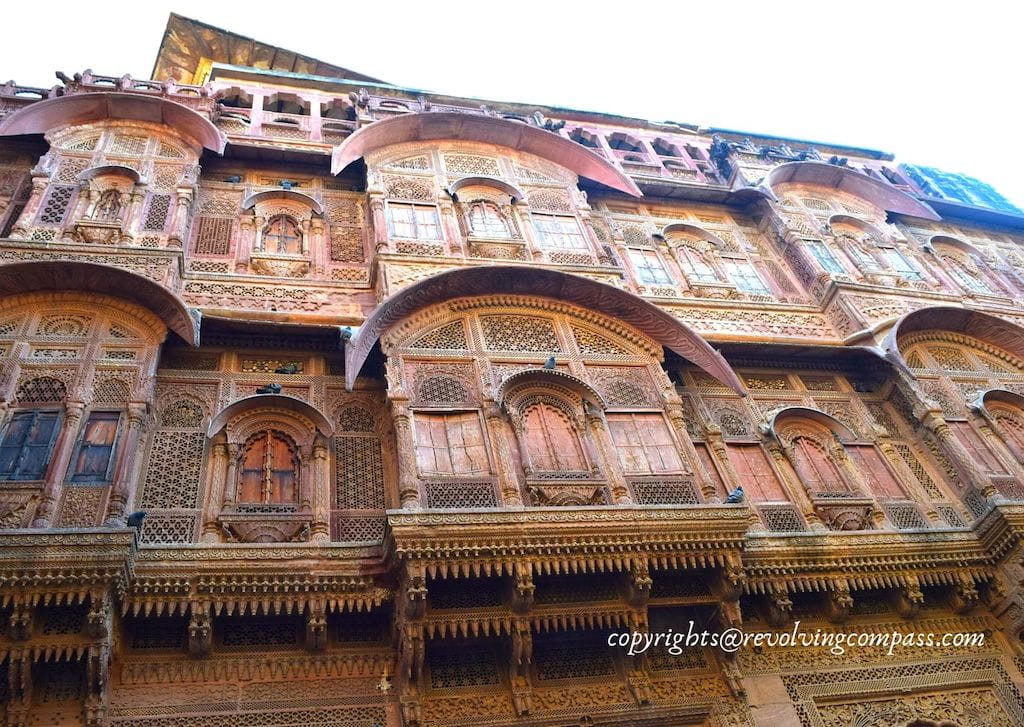
A three storey building built by king Ajit Singh. The name “Daulat Khana” literally means “Wealth store” or “treasury” . Maybe this building or part of it was used to store the wealth acquired by the royal kingdom. But, evidences suggest it was also a very important and prestigious royal building at that time. And was earlier referred to as “Ajit Vilas”. Presently, it houses the prized possessions of the museum inside Mehrangarh Fort Jodhpur. There is no particular category that these treasures belong to. While some of these are even war tents and war weapons. And then there are others like some intricate jewellery boxes, ornamented utensils etc.
Howdah Room
Next you arrive in room that displays different “Howdahs” from the 18th and 19th century. Some of these are very royal and intricately made.In fact the elephant seats displayed here that are a part of the royal collection are considered the finest in India. One of these were even gifted by the Mughal Emperor Shah Jahan. Apart from the Howdahs, one can also witness super beautiful and out of this world palanquins. In which the royal women used to sit. While some of these are very traditional, there are others that are more styled in European taste. Nevertheless, all of these are beautiful, very beautiful! So much so that you can’t help but wonder how it would feel like sitting in one and experiencing a short ride!
Sheesh Mahal
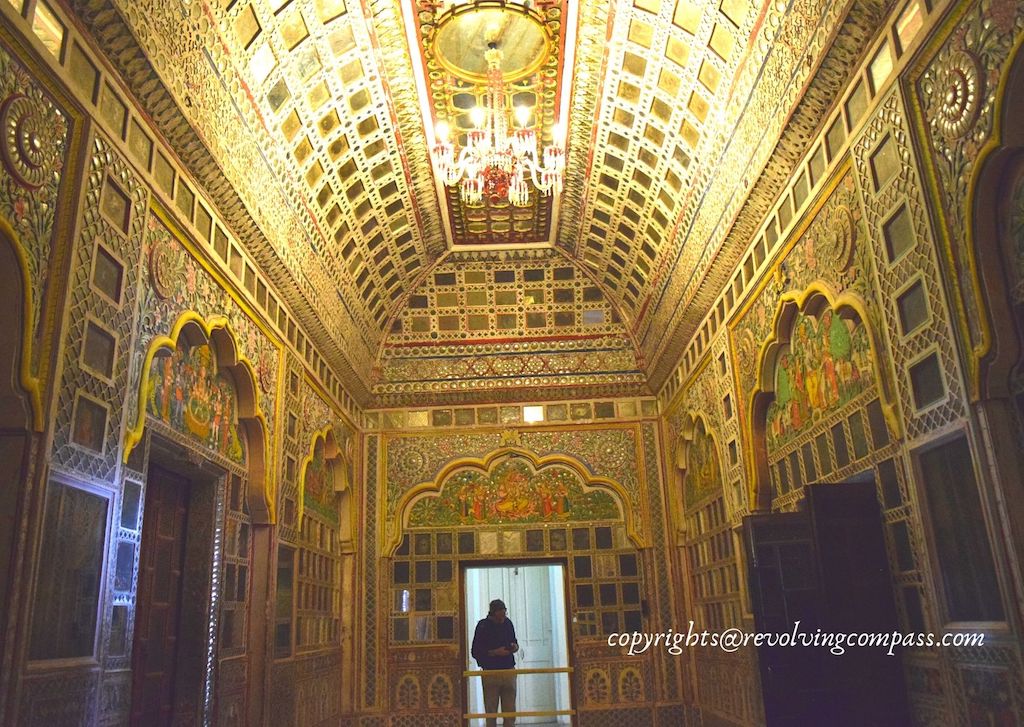
The term “Sheesh Mahal” means “A palace of mirrors”. Sheesh Mahals were quite famous in this era. As is evident from their presence in other palaces and forts as well like Amer Fort and Jaipur Palace. However the Sheesh Mahal of Mehrangarh Fort was an addition done by Ajit Singh. It is a part of the fort which was residential quarter of the Royal Family. The whole Sheesh Mahal wall and ceiling was covered in small sized mirrors. To create an infinite reflection loop. And the European chandeliers that one witnesses on the ceilings were added later in the 19th century. Near the arch of the Sheesh Mahal in Mehrangarh Fort one can also see paintings of several Hindu Gods and Goddesses.
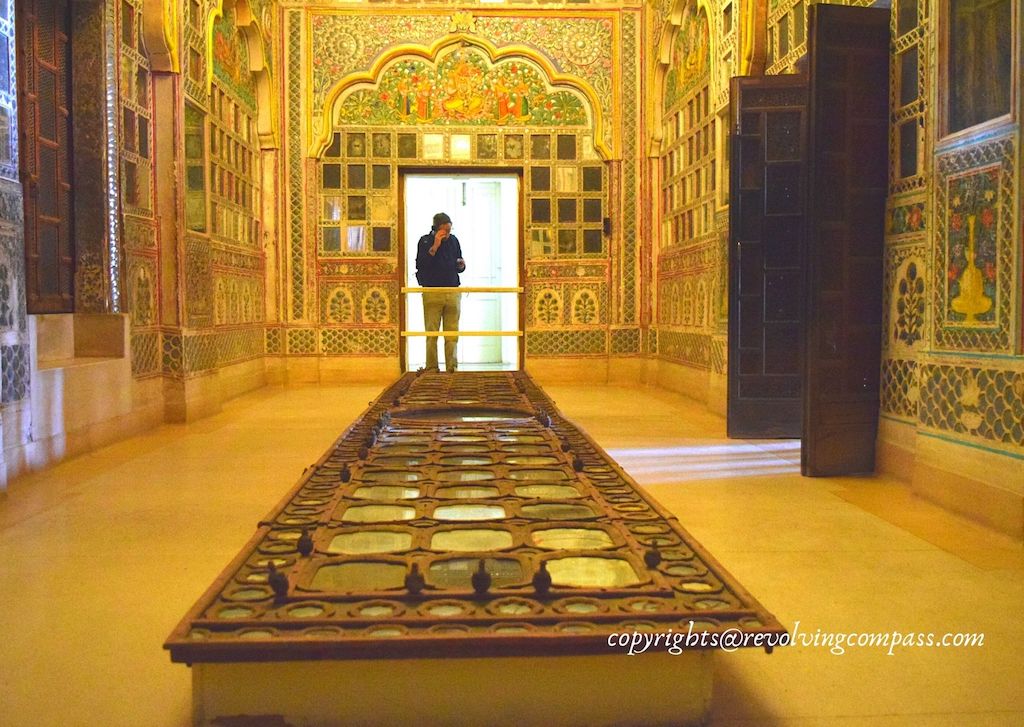
Actually the original roof also had a lot of mirror work on. But it collapsed sometime in the past. And is now kept on the floor of the Sheesh Mahal. So don’t forget to glance on the roof on the floor of Sheesh Mahal 🙂
Phool Mahal
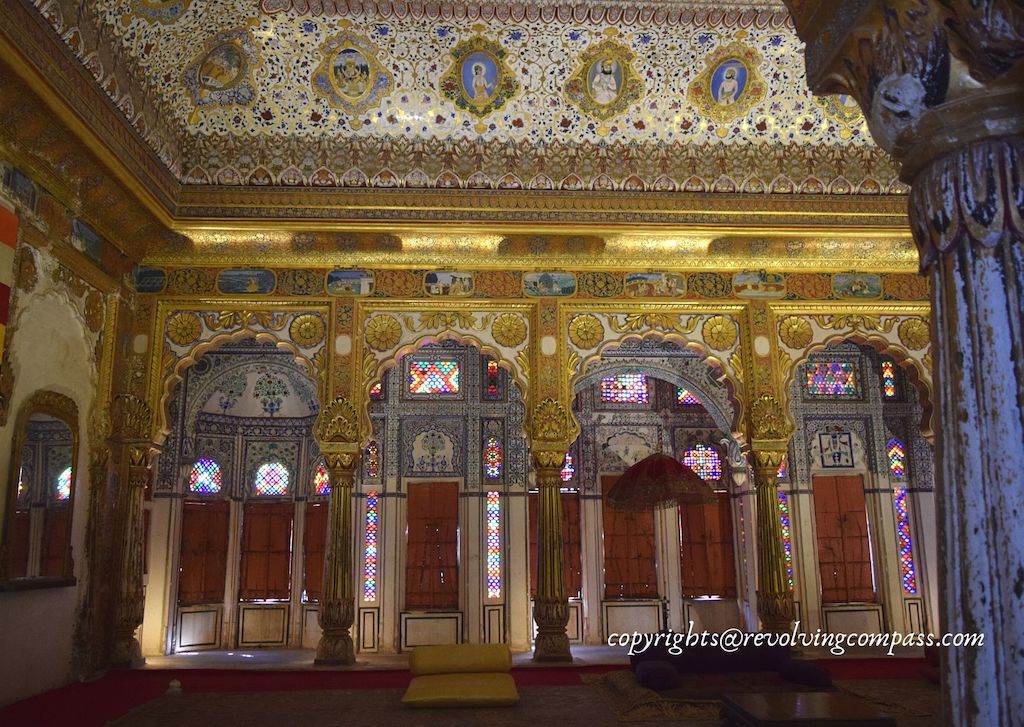
After Sheesh Mahal, one arrives at Phool Mahal. Phool Mahal is a beautiful hall ornately decorated. And surrounded by several rooms. It was the entertainment centre of the kings of erstwhile Mehrangarh Fort. The female dancers used to live in the chambers around the central hall. And they used to do dance performances here for the king’s entertainment. When viewed from a distance, the room represents a magnificent flower, intricately decorated in paintings, gold brocades and rag mala portraits. And that explains it’s name. (“Phool” literally means “Flower“)
Sileh Khana
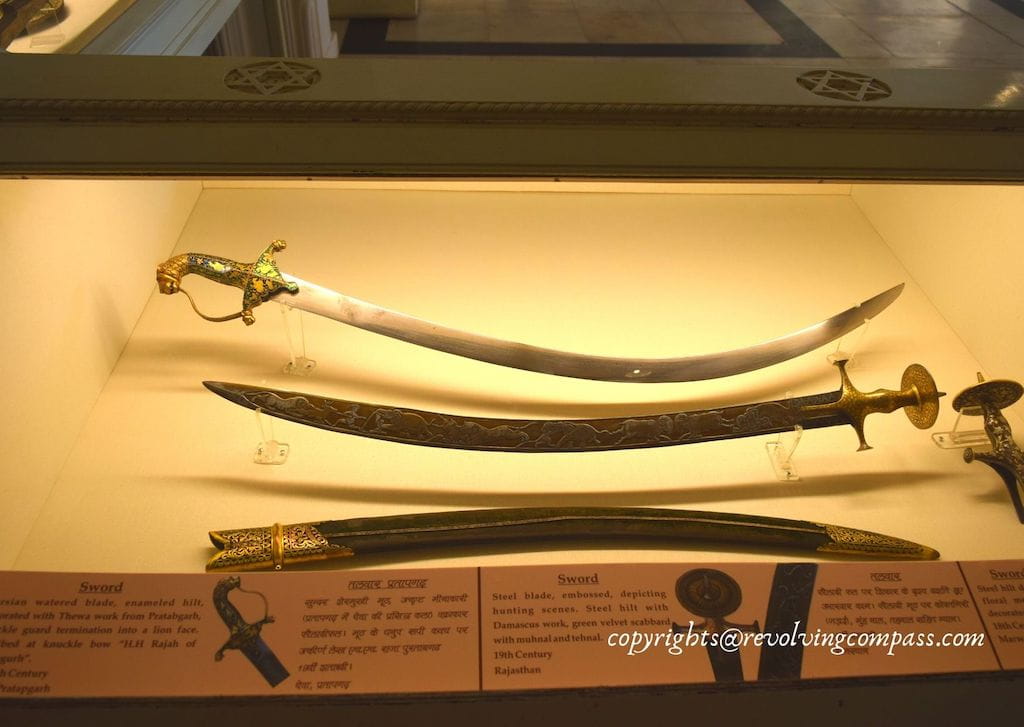
This chamber houses the armoury of the royal generations. And is something that really excited hubby dear. But to be honest, I was just glancing through and wondering – so many arms!! And couldn’t help think about the wars that must have been fought in and around this fort over the years (in fact, centuries!). Anyways, some of these weapons are really unique. And have been preserved to tell the tale of the great warriors that the royal dynasty of Mehrangarh witnessed. Totally worth a visit.
Takhat Niwas
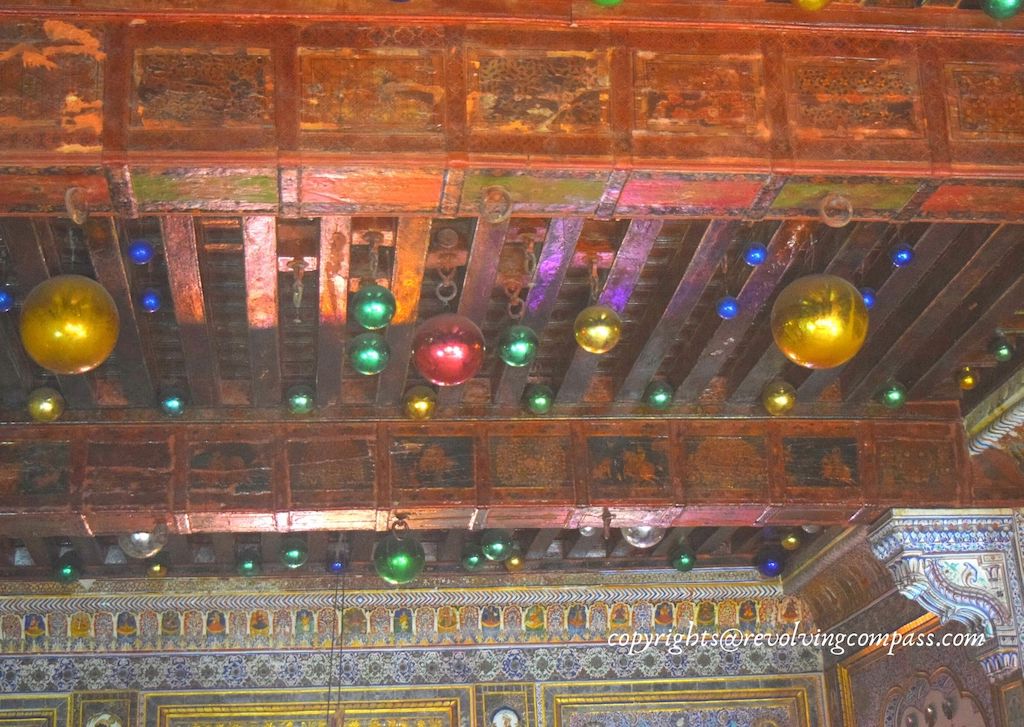
Next comes Takhat Nowas. Named after a Maharaja Takhat Singh, this villa or rather a grand room has architecture that shows resemblance to both Rajput and British style of architecture. There are numerous paintings depicting famous stories from the Hindu mythology. And a particularly noticeable feature are colourful balls hanging from the ceiling. Which, to be honest, seem a little out of the place with all the mythological paintings and the intricate carvings and other art forms around. So, what’s the deal? Seems they were gifted to the Maharaja by the British Empire. And were hung there for display!!
Another thing in Takhat Niwas that will catch your attention is the exceptionally short bed. Interestingly, the guide tells that the Maharaja wanted his feet to be touching the ground while he laid on the bed. Why, you must be wondering, as did we. Well, he wanted to be able to come up on his feet and running fast if there was an attack on the fort while he was napping!!
Before you leave Takhat Niwas, do remember to take a sneak peak into its windows to get a mesmerising view of the blue city of Jodhpur outside.
Jhanki Mahal
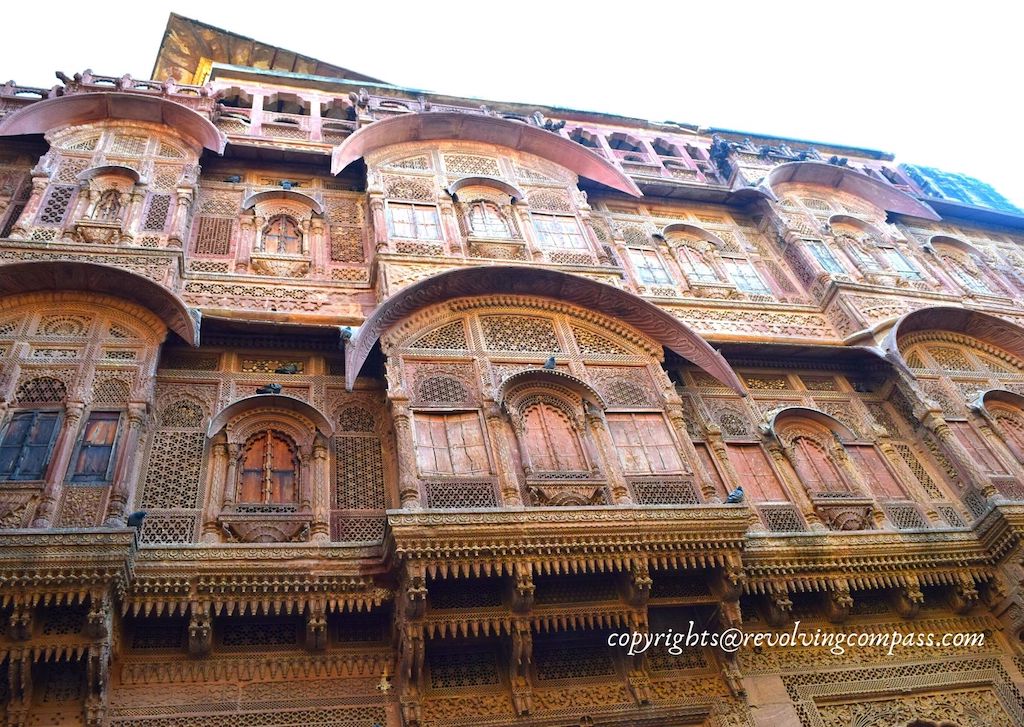
With Jhanki Mahal starts the women’s quarter of Mehrangarh fort. Just like Sheesh Mahal, there are Jhanki Mahals or designated Jhanki areas in most of the other palaces and forts of Rajasthan. And the complete exterior of the Hawa Mahal is made for Jhanki purpose. So what is all this about? Well, when royal possessions came out, the royal women got to see them through the numerous windows of the Jhanki Mahal. As, they were not allowed to directly venture in the public. Even ceremonies related to their husbands and sons, they had to witness through the jharokhas in the Jhanki Mahal only. In fact the word “Jhanki” literally means “Possession”. Now a days, the Jhanki Mahal is turned into a display gallery of some of the most royal and intricate cradles that obviously were once beds of the royal prince and princess.
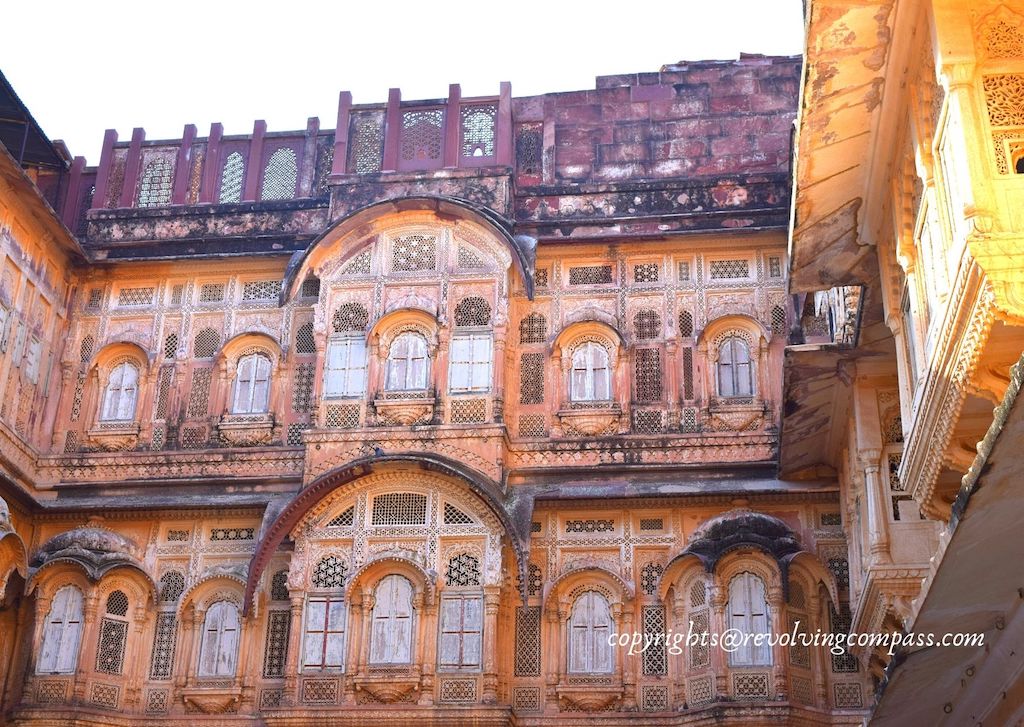
Before you exit the Jhanki Mahal, do remember to glance on it’s ceiling as well, which is beautifully painted in blue flowers.
Moti Mahal
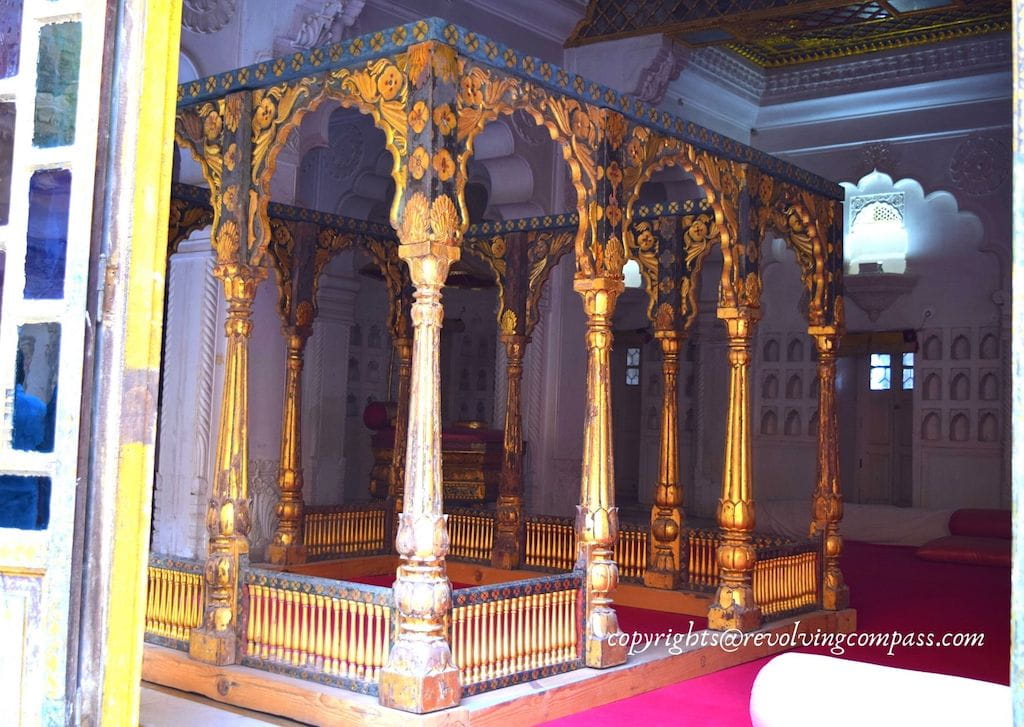
One of the oldest and grandest parts of the Mehrangarh fort is Moti Mahal. Maharaja Sur Singh built this palace in the 16th century and used it as his Diwan-e-am. Wherein he used to meet his important ministers and discuss the matters of the empire with them. Particularly characterised by colourful moroccan style mirrored gates and golden ceiling, that wonderfully compliment the whitewashed simple walls, Moti Mahal indeed looks grand. And very specious.
Zenana Deodi
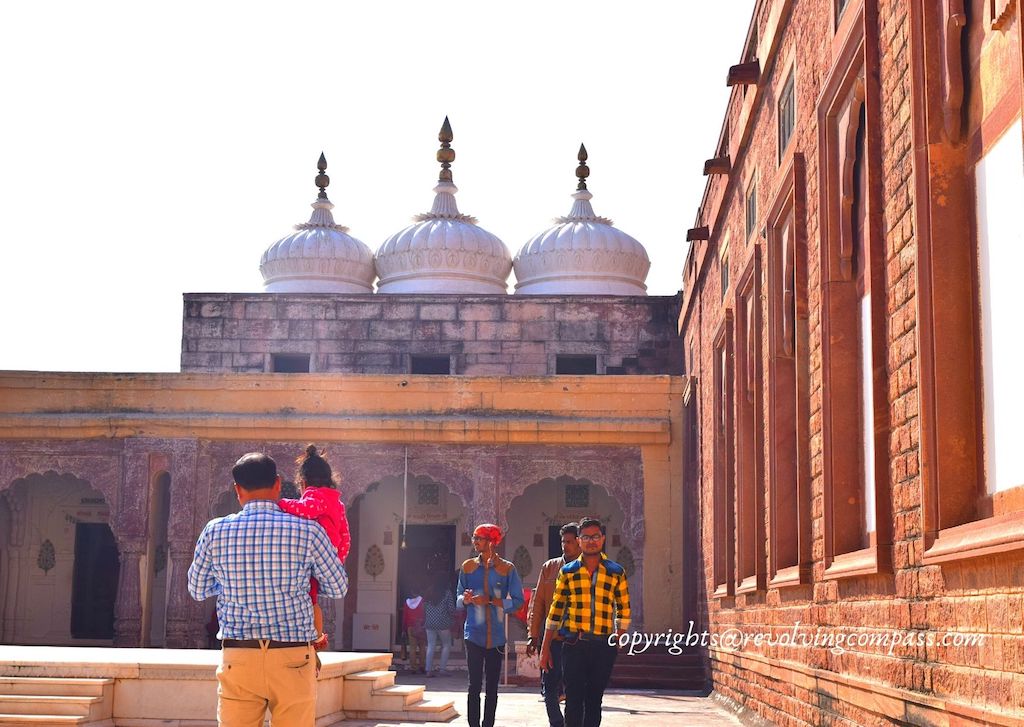
After Moti Mahal, one reaches the “zenana deodi” or the “women’s courtyard”. Apparently, this courtyard is a part of the fort wherein the royal women lived and spent a lot of time. Speciality of this courtyard is the intricate carvings and sculpturing work that you can witness on the walls and doors surrounding this courtyard. Particularly noticeable here are the sandstone windows and the carvings on them. Before existing from here, you get to enter the Museum shop from where you can shop some souvenirs. Also, you get to cross a vast stretch of courtyard.
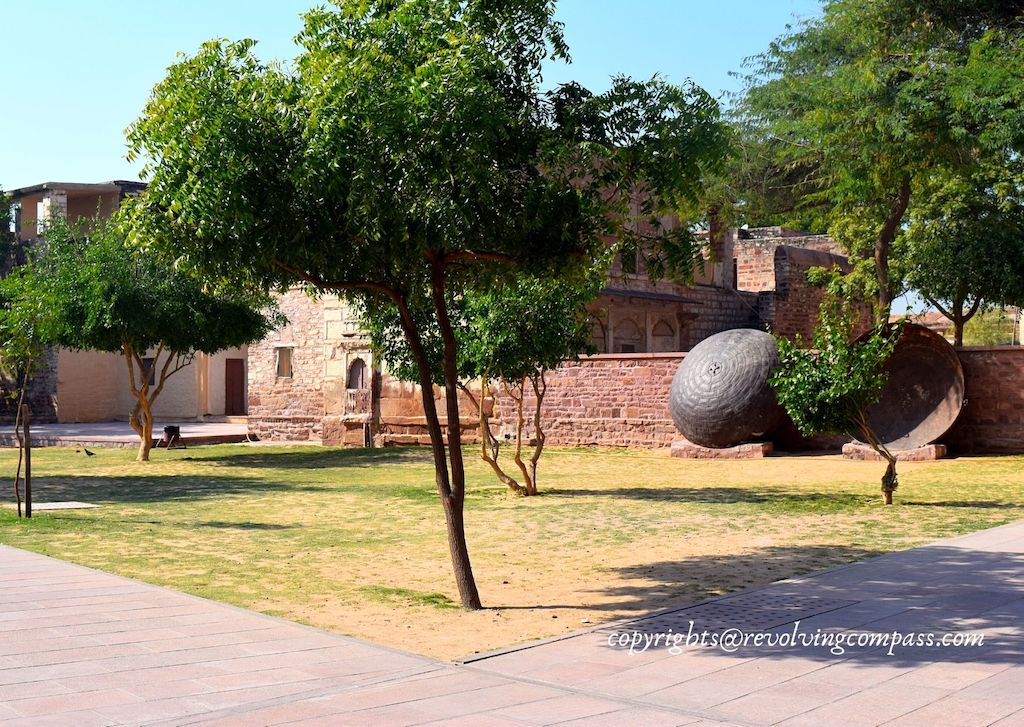
And see canons lined on the massive wall of the fort, a testimony of it’s solid defence structure:
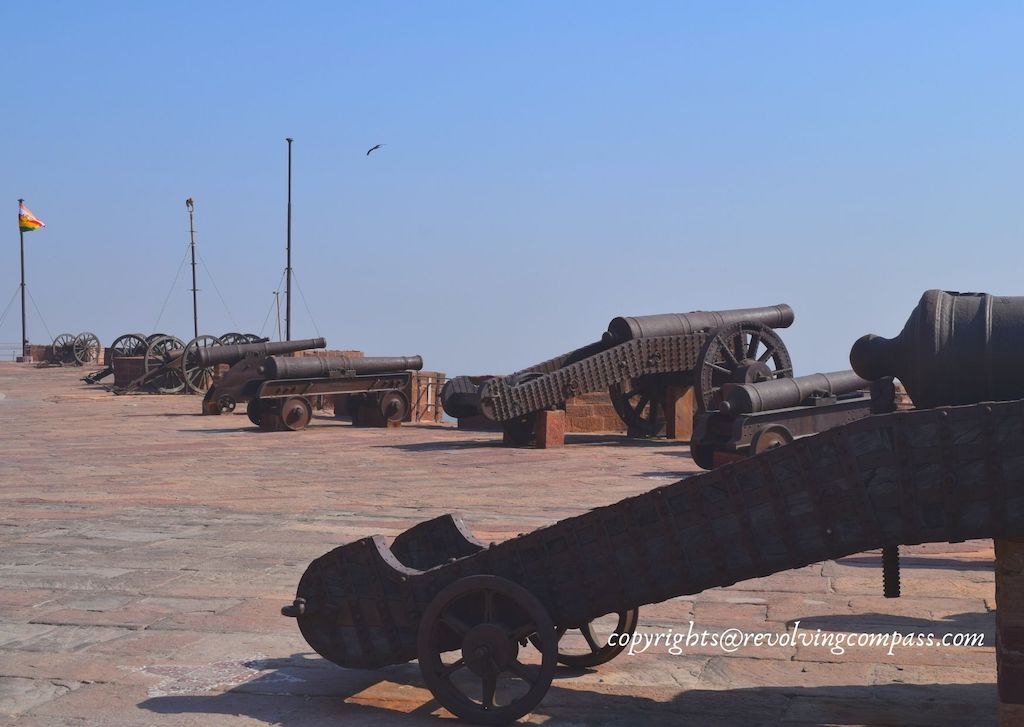
Mataji Temple
After finishing a visit inside the different sections of the fort described above, and exiting out of the seventh gate, one can proceed towards Mataji Temple. It’s almost half kilometer from the Zenana Deodi. On the way, you can notice a beautiful pond below with a Shiva Statue. Finally, you arrive at a flight of stairs that lead to the temple. The Chamundi Mataji is the Goddess of the Royal Family. And the kings offered their prayers in this temple before taking up any important endeavours, particularly when stepping into strategic decisions and going on wars.
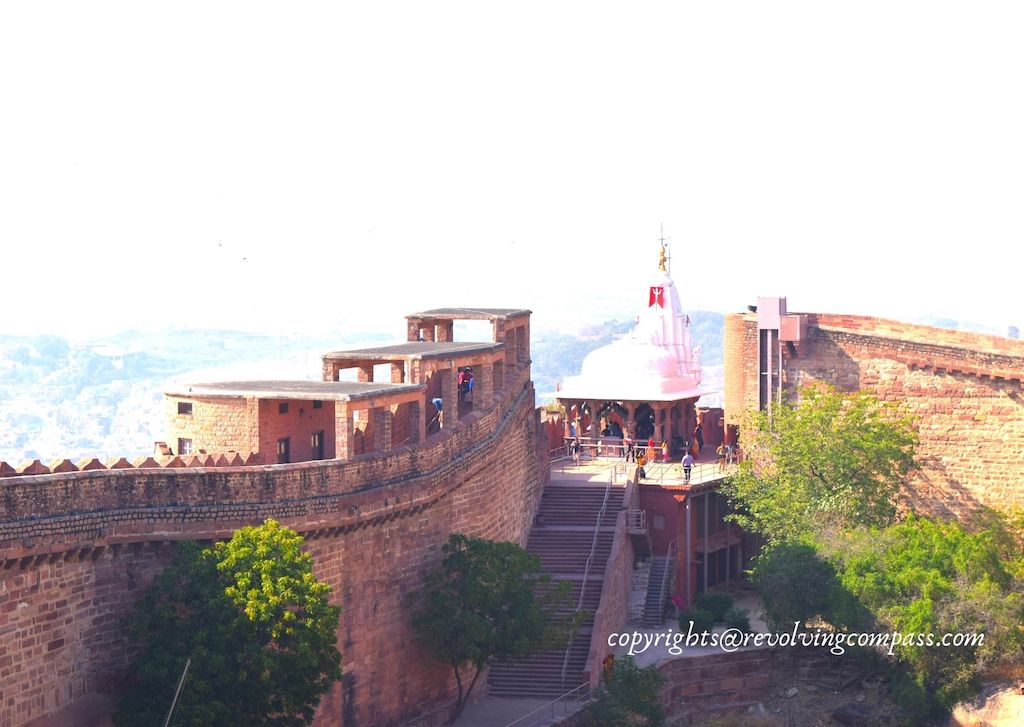
Rao Jodha Desert Park
A very recent addition to the area, and not really a part of the main Mehrangarh Fort. But now, Rao Jodha Desert Park is a must visit when visiting the Mehrangarh Fort Jodhpur. It was built in 2006 just outside the fort. It hosts a plethora of rock and arid weather suitable flora. It’s beautifully landscaped. And presents soothing patches of green between the otherwise rocky terrain of the desert land. Given that the park opens as early as 7:00am in summer months and by 8:00am in winter months, one can plan to visit here before visiting the fort. Since, the park is all open with very little shade, its best to visit here in the early morning hours.
Interesting facts about Mehrangarh Fort Jodhpur
The peculiar foundation of Mehrangarh Fort
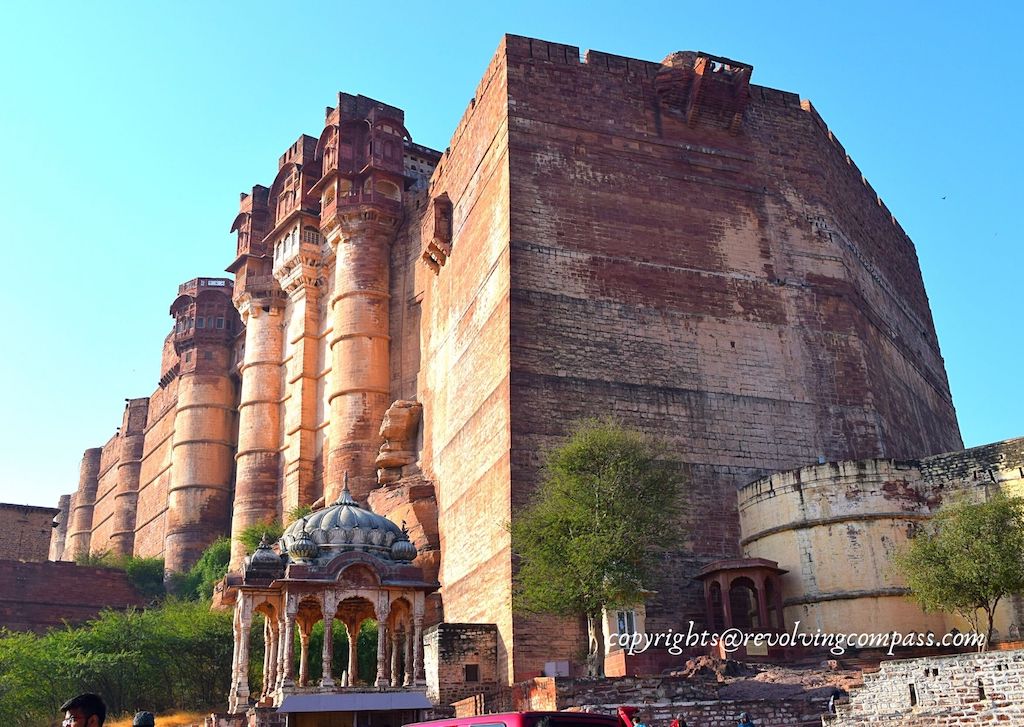
Mehrangarh fort is built at a very peculiar geographical spot. It is a place where two different kind of rocks are piled one on top of the other. The lower pile of rock is a formation from the molten material from a volcanic eruption that happened more than 750 million years ago!! While the upper rock is sandstone – layers of earth accumulated over a swallow sea over a period of some 500-600 million years. Isn’t this peculiar layering of rocks – the foundation on which Mehrangarh Fort proudly stands atoll – itself very intriguing?
The massiva and expansive walls & gates of Mehrangarh Fort
The Mehrangarh Fort is guarded by not one , two but 7 massive fort gates. These are named as Jai Pol, Loha Pol, Fateh Pol, Amrita Pol, Doodkangra Pol, Gopal Pol and Bheru Pol. The walls of the fort spread far and wide. And at the time when it was built, the whole population of the empire lived inside the boundaries of this fort! However, as the number of people in the kingdom of Mandore increased over a period of time, people started to live outside of the fort, around it. And that is what constitutes the typical blue houses of the brahmins that one predominantly sees from atop the Mehrangarh Fort.
The legend of Cheeria Nathji
It is said that when Rao Jodha decided to build Mehrangarh Fort at the hill, at that time, a hermit Cheeria Nathji (meaning “Lord of Birds) lived here. Rao Jodha had to make him shift elsewhere in order to be able to construct the fort there. Upset on this, Cheeria Nathji cursed him and the fort stating that the region would always live in water scarcity. And ever since, the whole area is a dry land. It suffers from drought every few years. And rains are scarce in this region!!
The story of Johar
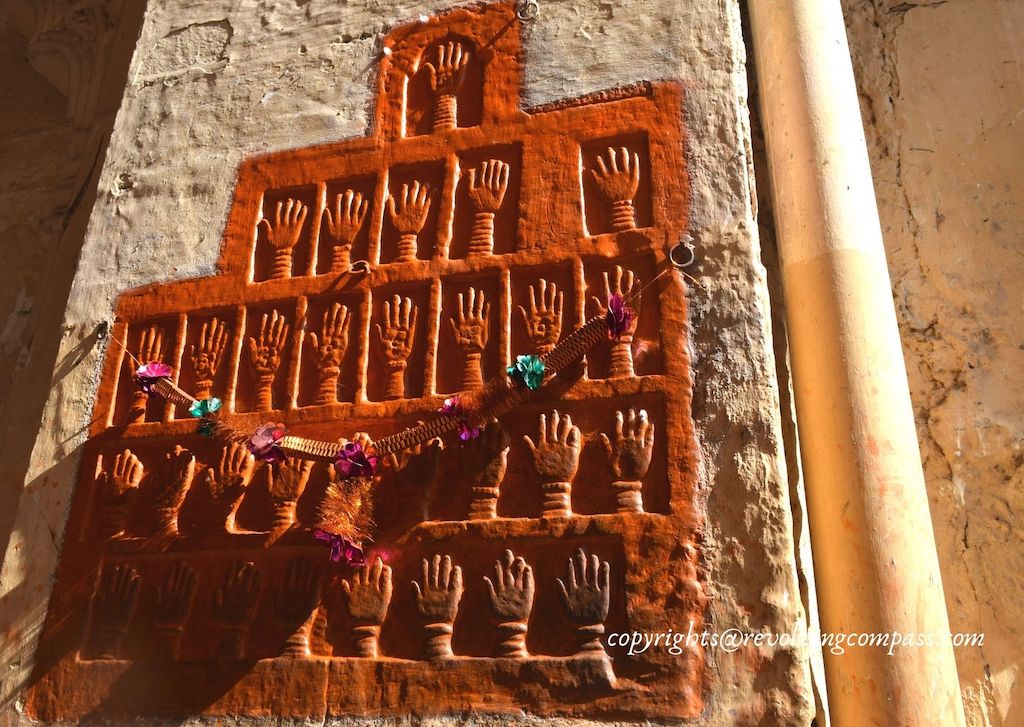
As you see these hand prints on the wall besides one of the exit doors, you will feel a chill shiver through your spine. As these hand prints recall one of the “Johar Ceremony” performed by the royal ladies and their helpers. The women of the fort, whenever felt insecure upon invasion by an outsider, performed this ceremony around the huge fire. Burning themselves alive, rather than submitting to the conquerer. Also, when the king died, their wives would burn themselves alive on their husband’s pyre, another ritual that was known as “Sati” and was practiced almost country wide !!
The human sacrifice of Rajaram Meghwal
Further, the story goes that to help protect the empire from the curse put by Cheeria Nathji, a sacrifice of a human being was needed. The person, Rajaram Meghwal, who volunteered for the sacrifice, was burried alive in one corner inside the premises of the fort. (Well, yes, it is difficult to digest but things like these were ways of life in that era. Just like regular wars). And in turn, the king promised that his family would be taken care of. Ever since, through generations, till date, the royal family has been taking care of the family and descendants of Rajaram Meghwal. Well, now that is called a royal promise!!
The cultural patronage of Mehrangarh Fort Jodhpur
Another unique fact about the Mehrangarh Fort Jodhpur that one can easily observe while passing through the fort is its cultural patronage. One can see it in the form of painting galleries all through the fort. And next in the rich and well preserved items in the museum inside the fort. Moreover, there are regular cultural dance and song performances inside the premises of the fort itself. While the fort has musicians performing folk music at the entrance. There are also regular craft bazars (markets) and traditional melas (fares) hosted inside the Mehrangarh Fort.
General tips on visiting Mehrangarh Fort Jodhpur
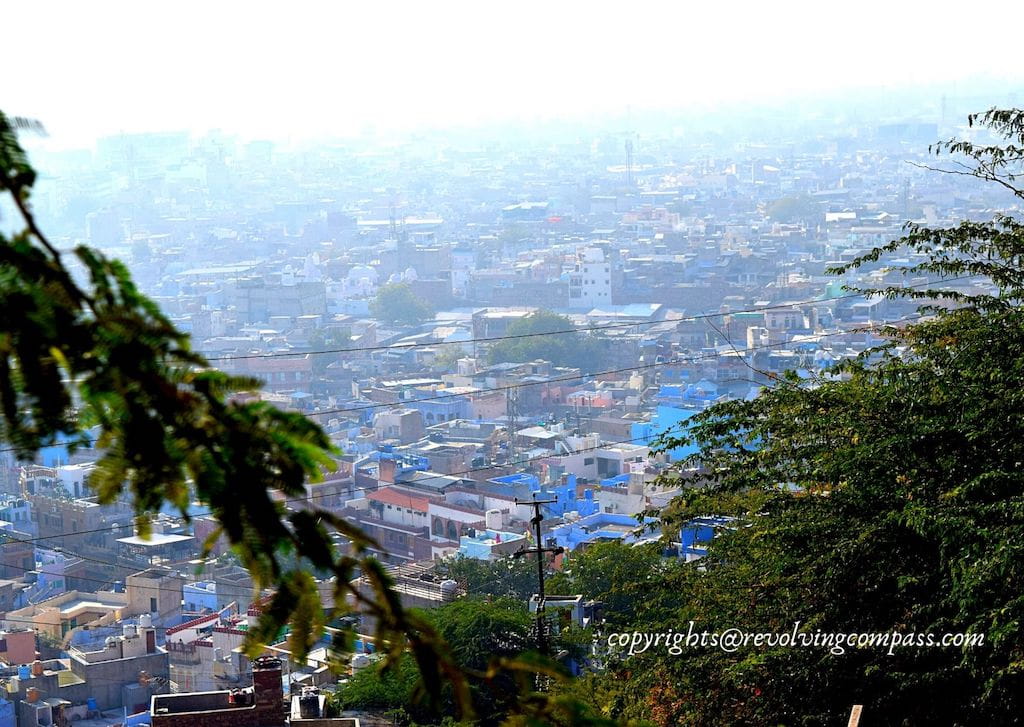
- Visit as early as possible. As the fort opens its gates to visitors by 9:00am and it gets super crowded by 10:30am in the peak season months.
- There is on premise restaurant but it is costly and has limited option. You can either eat here or once done with visiting the fort, head to main market of Jodhpur near the clock tower and have food there.
- Wear comfortable shoes as there is a lot of walking uphill and downhill to be done. Particularly while entering the fort. And also while visiting the Mataji temple.
- Carry an umbrella as even if you start your day early in the morning, by the time you exit the fort it will be noon.
- Do carry drinking water with you as it is important to keep sipping water and keep yourself hydrated as you roam around the fort. As the weather is hot and dry for most part of the year.
- Government designated guides are available at the fort and the price is also fixed. You can check it at the ticket counter.
- The fort is open from 9:00am to 5:00pm. And there is a nominal entry fee to the fort.
PS: Some of our links are affiliated, this means we will earn a commission when you buy a service or product by clicking those links. However, this will have no extra cost for you.
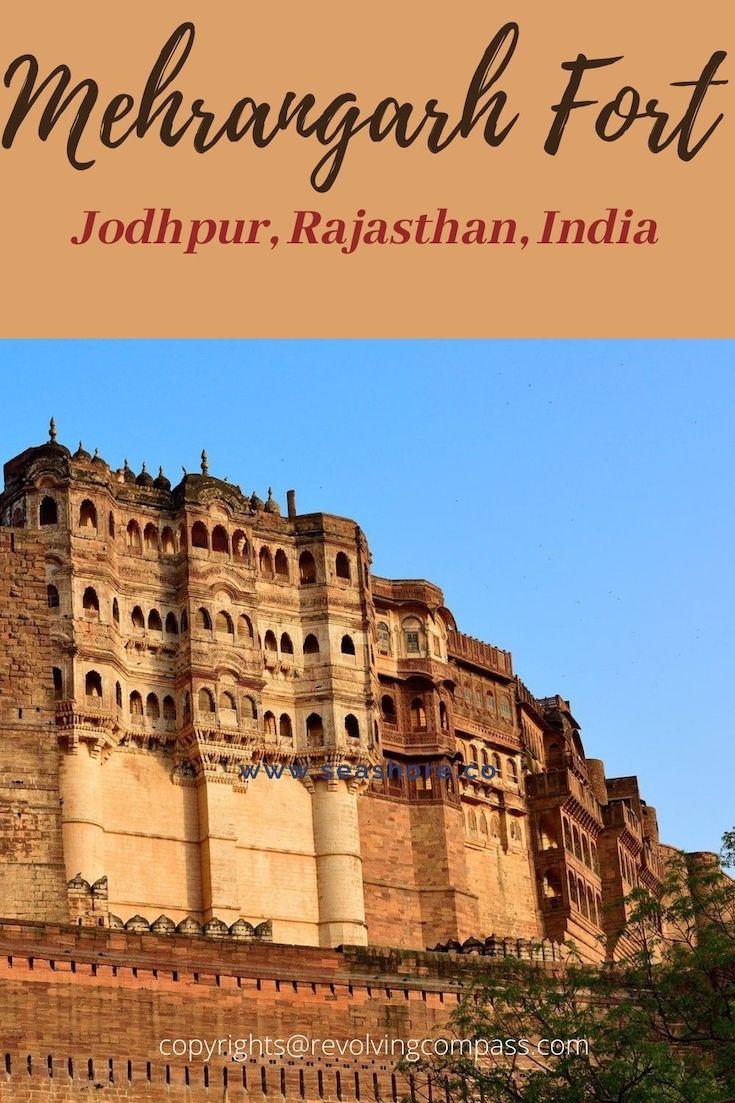 |
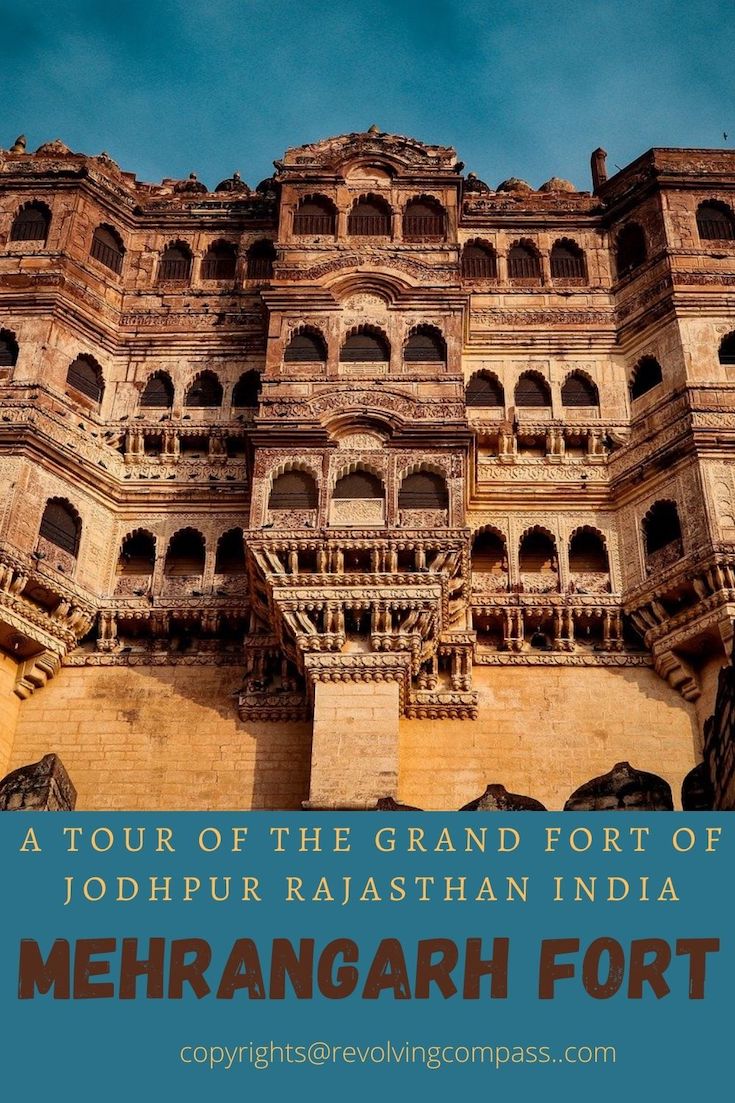 |
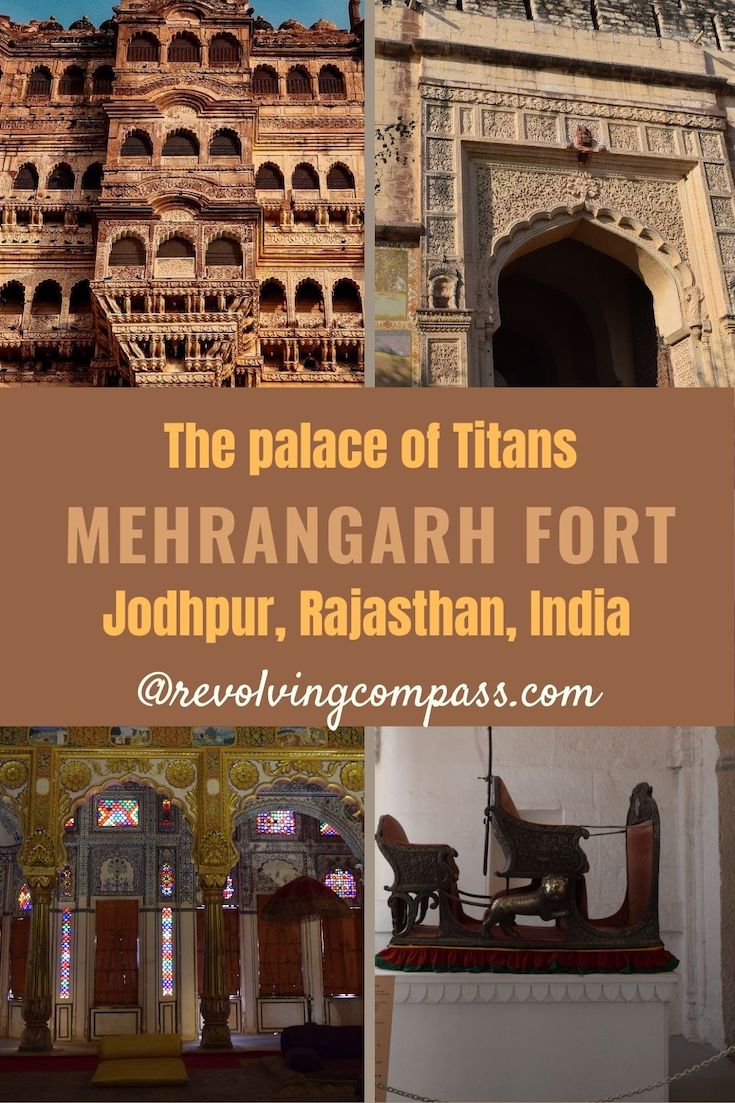 |
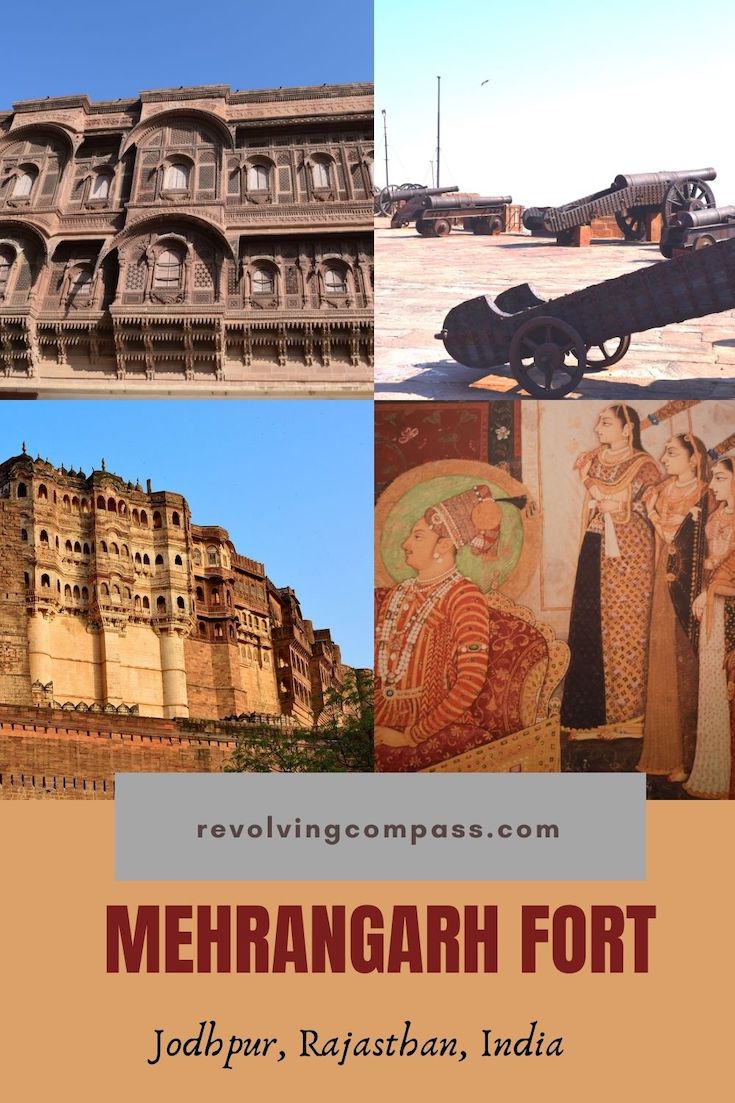 |
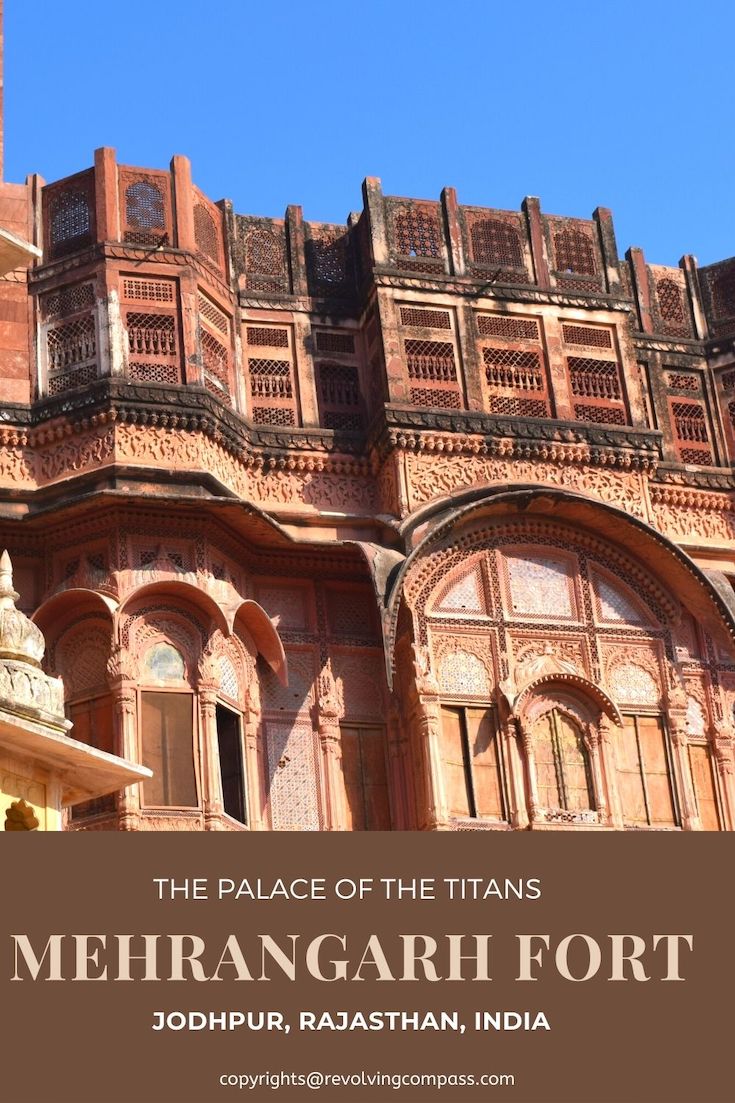 |
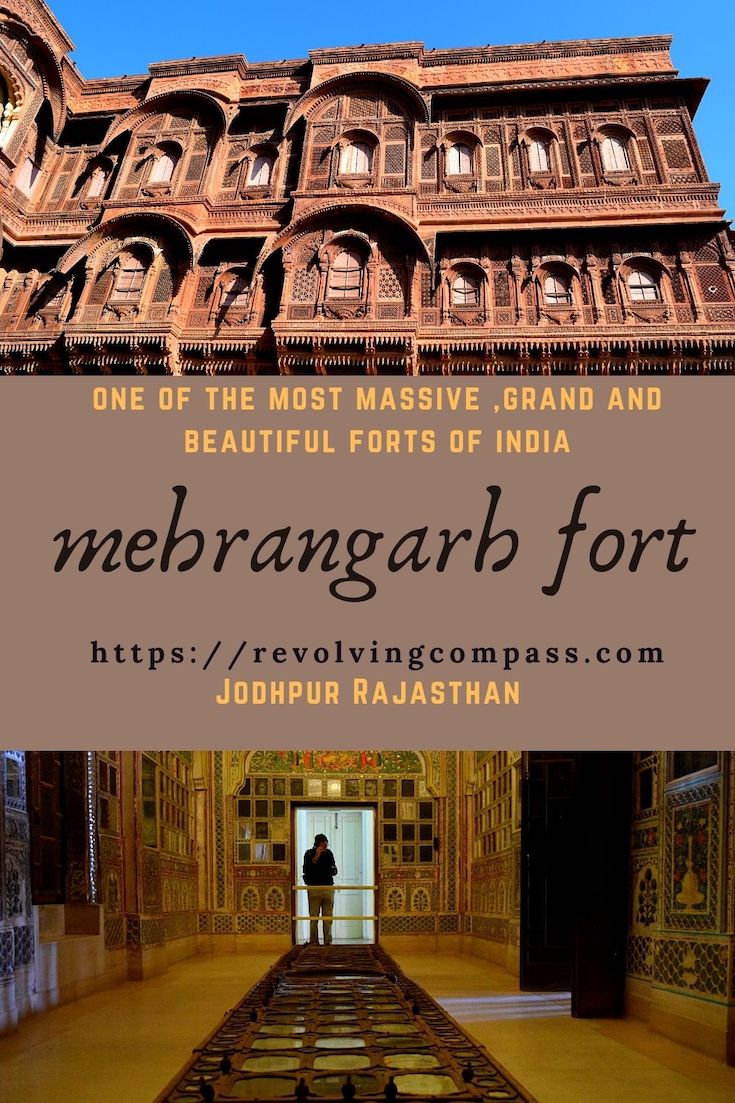 |
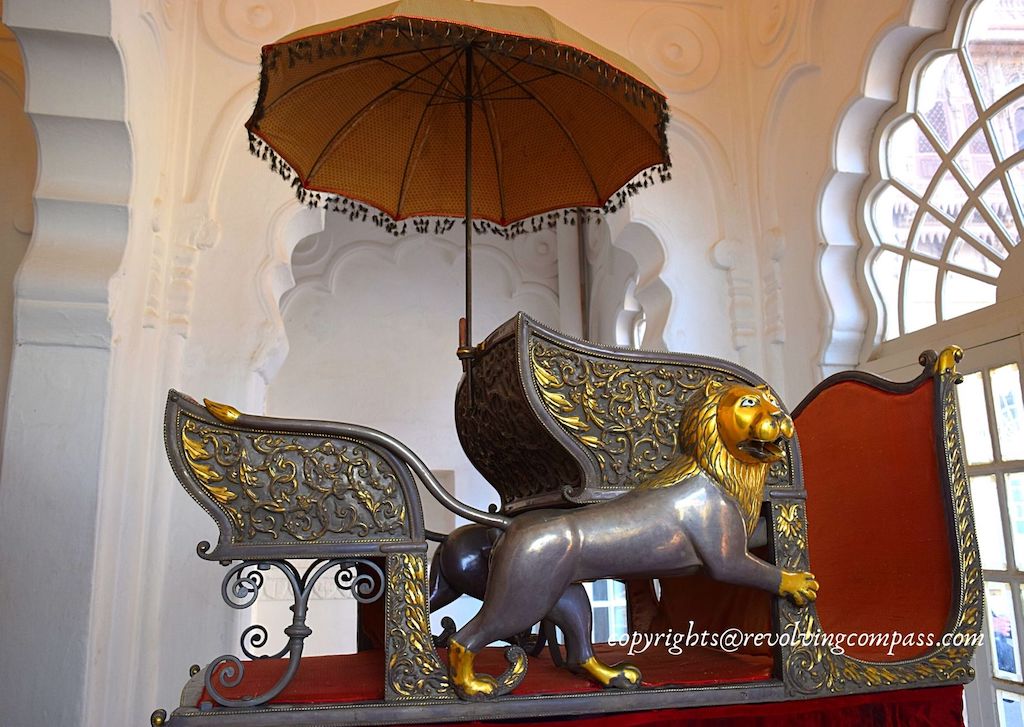
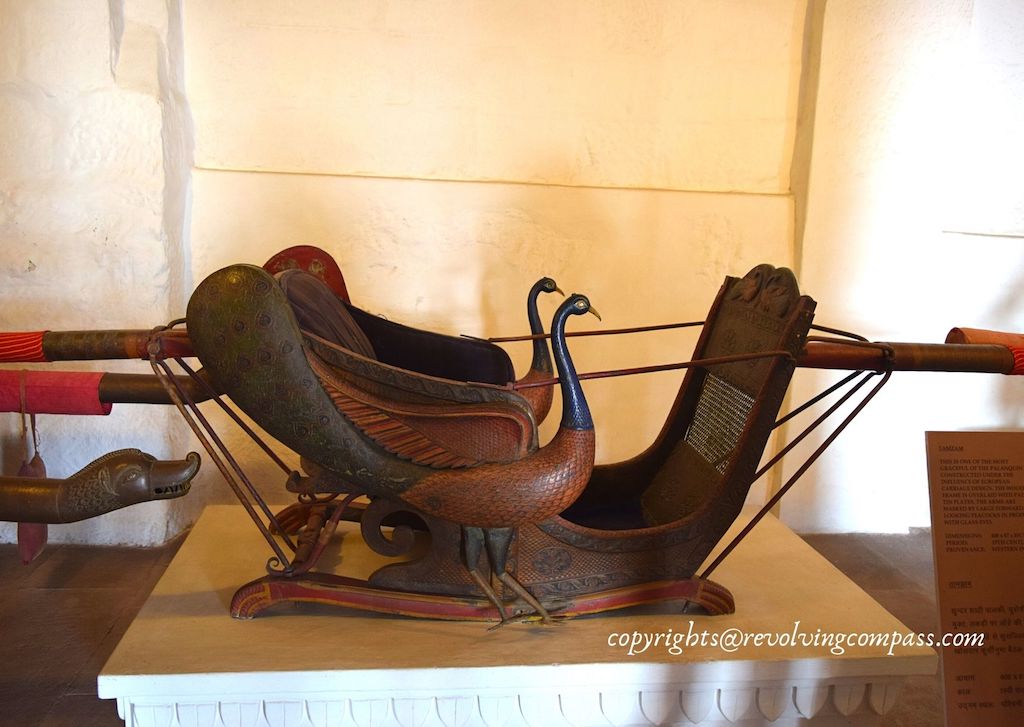
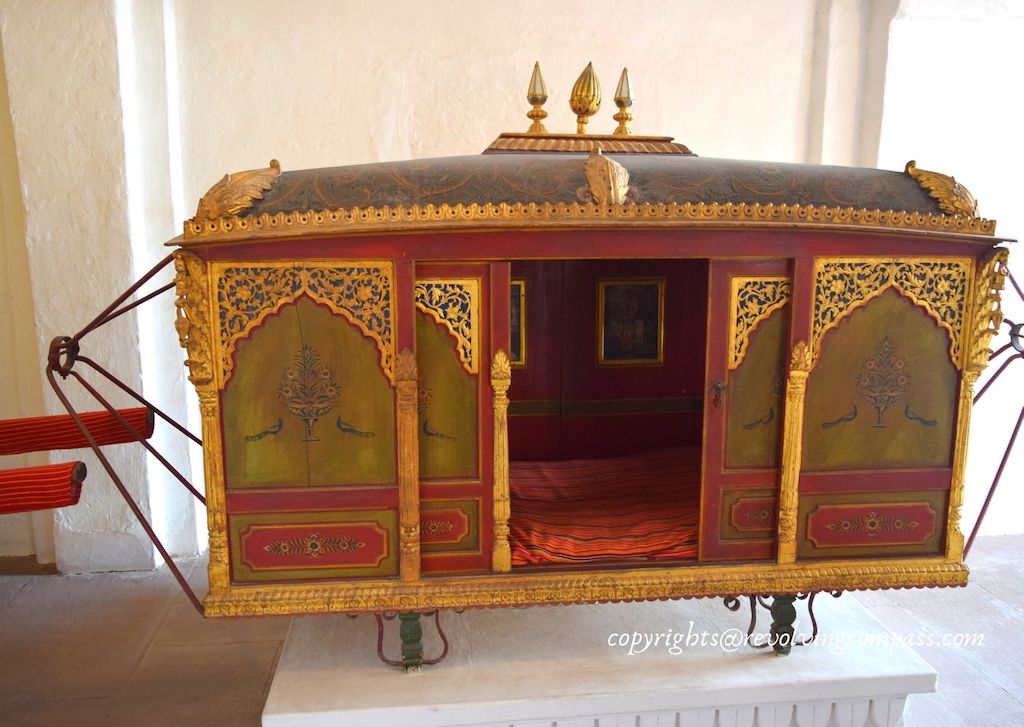
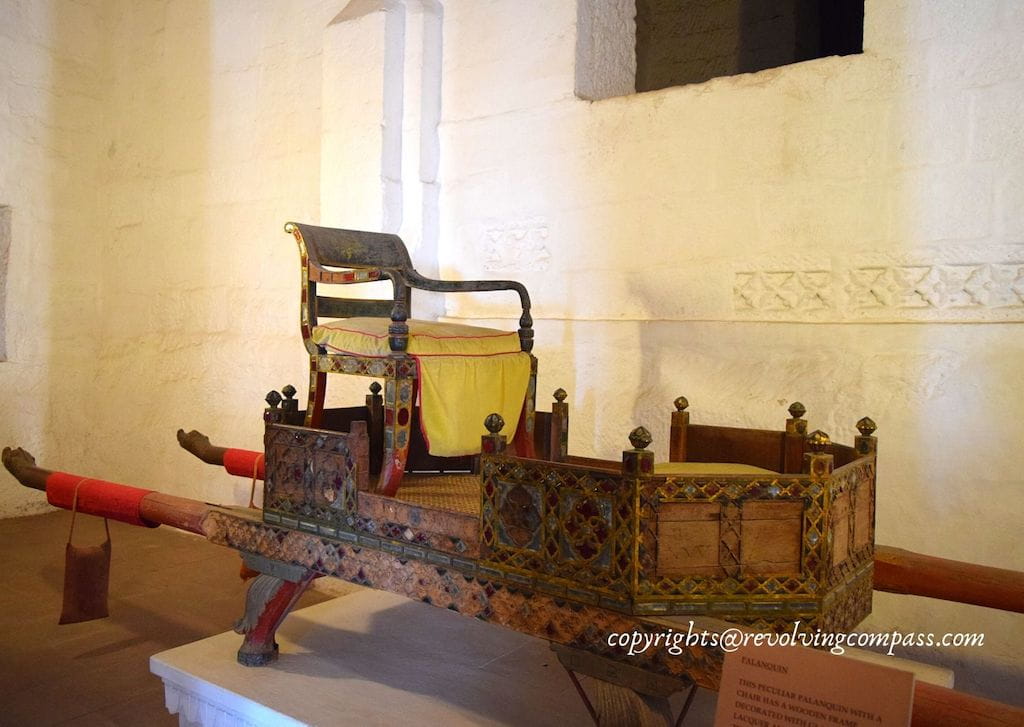
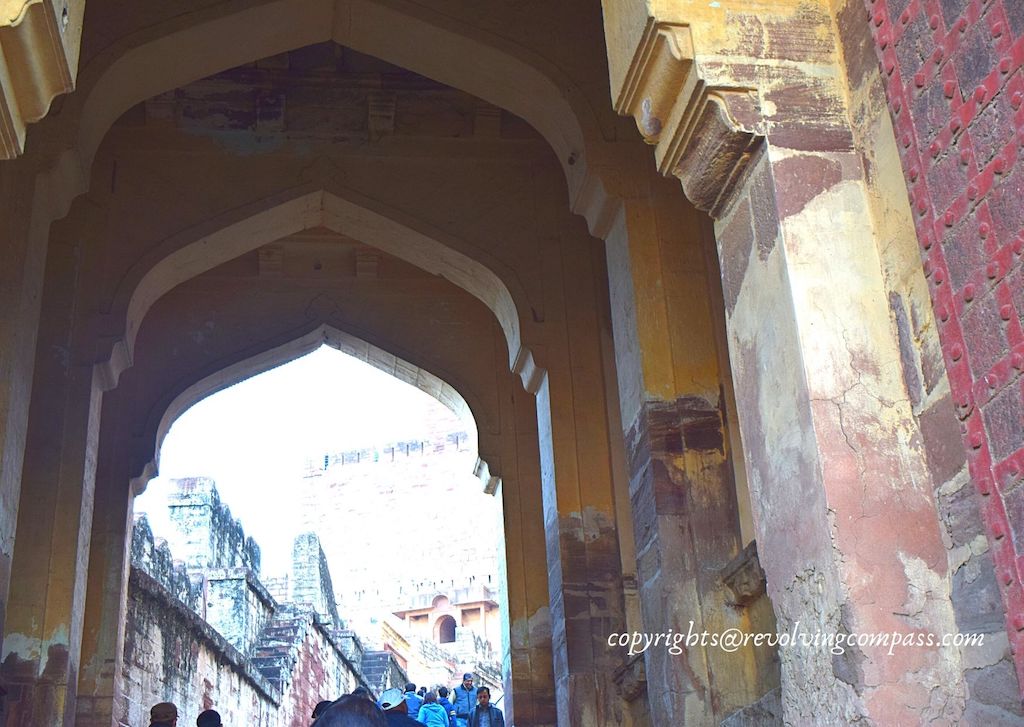
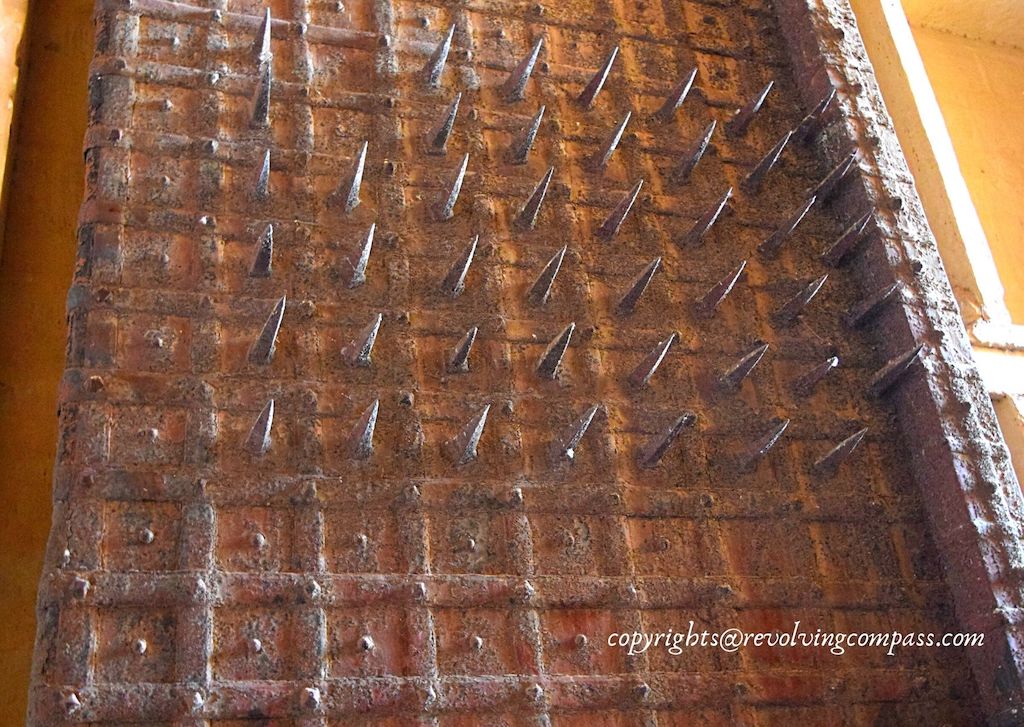
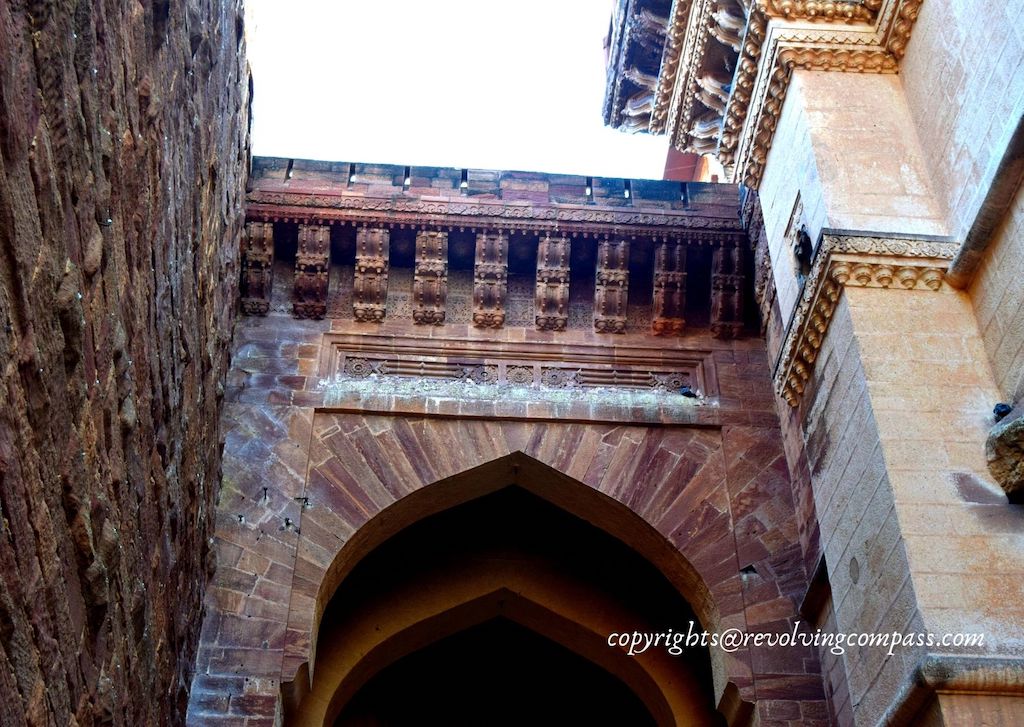
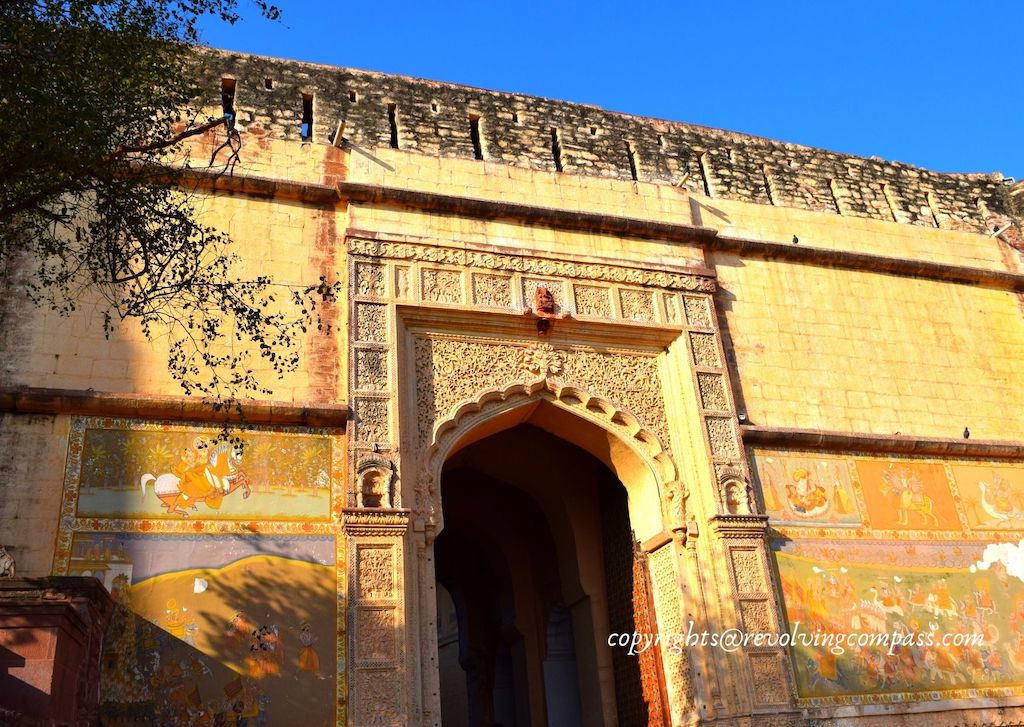
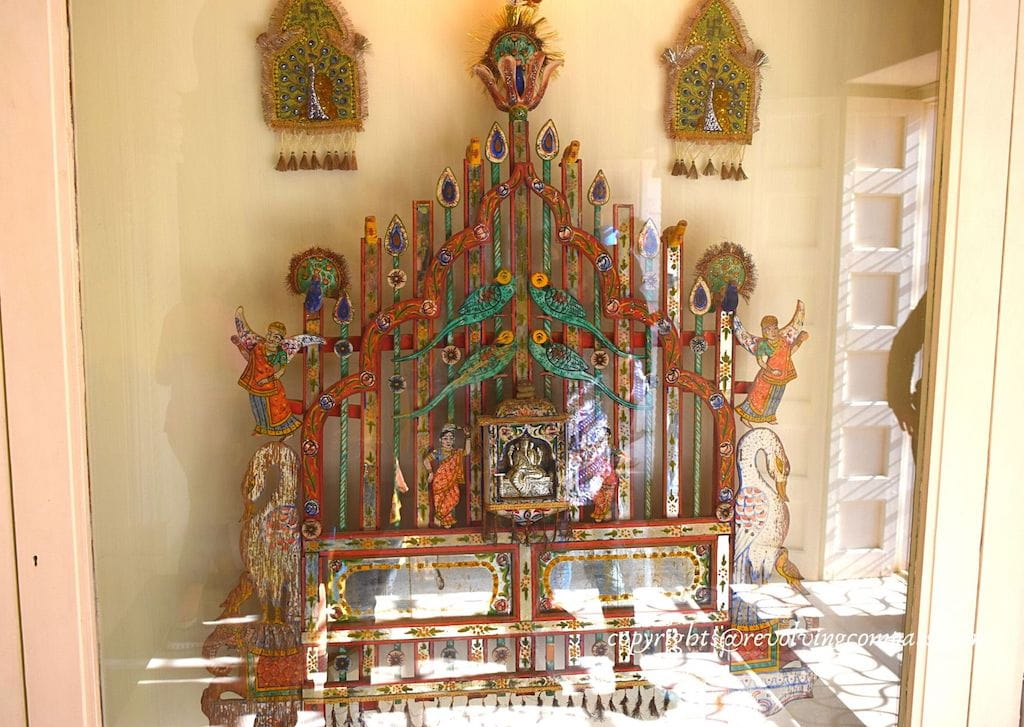
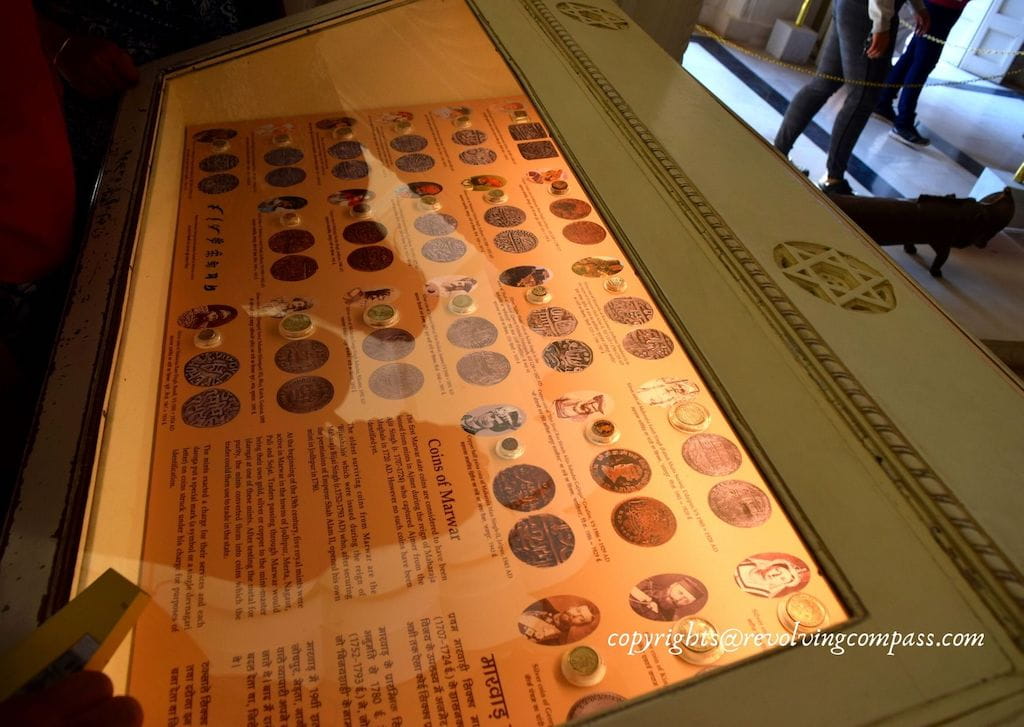
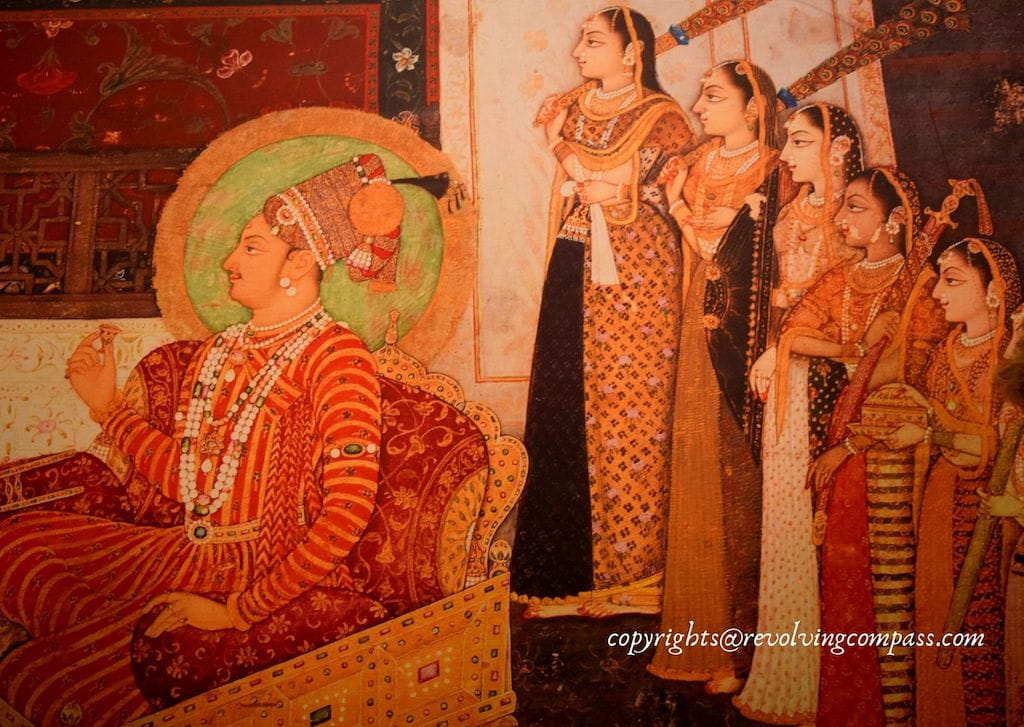
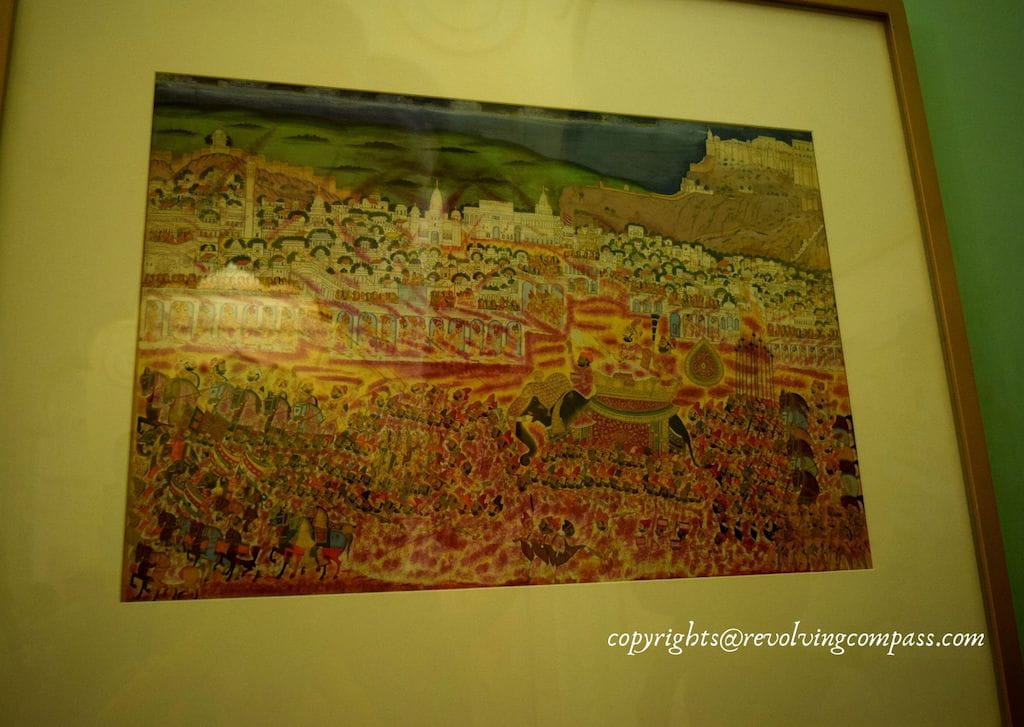
Well written but the handprints are of women who committed “jauhar”. Sati is lying on the pyre of the husband (as mentioned rightly in the last line), but the handprints are of women who committed jauhar – a tradition popular amongst the rajputs wherein when the king is martyred on the battle field, the women of the royal family (married, unmarried, maids etc.) and sometimes even women of the city would jump into a well of fire (agni kund) alive so as to protect their honour than get dishonoured by the men of the enemy. So while sati is restricted to just one woman or the wives of one man who has died (since polygamy was the norm then), jauhar is more of a community practice and ritual.
Thanks for pointing it out Vidya!
Thank you so much for giving us such good knowledge we appreciate your blog Some travels related suggestions are also on our muskan tours page Muskan Tours & Travels provides some incredible and luxurious services in Udaipur Rajasthan with the best experience. For those people who want the best tour & travel agency in Udaipur Rajasthan with good facilities, you can visit their website for more details. Or you can call on this number +91- 9799284111
Hi, loved your blog. I was literally was going through the each and every place the way you have mentioned it with the pictures. Great content. Keep posting.
Thank you so much Pooja. Its comment like yours that totally make our day!!
Wrong photo of shringar choke.
Thanks for pointing, corrected!
King Ajit Singh instead of Arijit Singh
Thanks for pointing the error Divya
Awesome!!!
thank you Chhavi!!
Very nice and the best blog. Also very useful.
Thank you so much Chhavi! you made our day